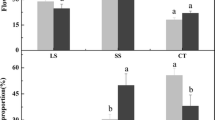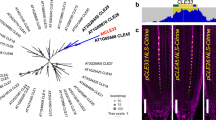Abstract
Arabidopsis thaliana (L.) Heynh. has been used as a model system to investigate the regulatory genes that control and coordinate the determination, differentiation and morphogenesis of the floral meristem and floral organs. We show here that benzylaminopurine (BAP), a cytokinin, influences flower development inArabidopsis and induces partial phenocopies of known floral homeotic mutants. Application of BAP to wild-type inflorescences at three developmental stages results in: (i) increase in floral organ number; (ii) formation of abnormal floral organs and (iii) induction of secondary floral buds in the axils of sepals. These abnormalities resemble the phenotypes of mutants,clv1 (increase in organ number),ap1,ap2,ap3 (abnormal floral organs) andap1 (secondary floral buds in the axils of first-whorl organs). In addition, BAP induces secondary floral buds in the axils of perianth members ofapt2-6, ap3-1 andag mutants, and accentuates the phenotype of theapt2-1 mutant to resemble theapt2-6 mutant. These observations suggest that exogenous BAP suppresses the normal functioning of the genes for floral meristem identity and thereby affects flower development and the later stages of floral organ differentiation.
Similar content being viewed by others
Abbreviations
- BAP:
-
N6-benzylaminopurine
- CK:
-
cytokinin
References
Bernier G (1988) The control of floral evocation and morphogenesis. Annu Rev Plant Physiol Plant Mol Biol 39: 175–219
Bernier G, Havelange A, Houssa C, Petitjean A, Lejeune, P (1993) Physiological signals that control flowering. Plant Cell 5: 1147–1155.
Bowman JL, Smyth DR, Meyerowitz EM (1989) Genes directing flower development inArabidopsis. Plant Cell 1: 37–52
Bowman JL, Sakai H, Jack T, Weigel D, Mayer U, Meyerowitz EM (1992)SUPERMAN, a regulator of floral homeotic genes inArabidopsis. Development 114: 599–615
Bowman JL, Alvarez J, Weigel D, Meyerowitz EM, Smyth DR (1993) Control of flower development in Arabidopsis thaliana byAPETALA1 and interacting genes. Development 119: 721–743
Drews GN, Bowman JL, Meyerowitz EM (1991) Negative regulation of the Arabidopsis homeotic geneAGAMOUS by theAPETALA2 product. Cell 65: 991–1002
Durand B, Durand R (1990) Sexual determination and sexual differentiation. Crit Rev Plant Sci 9: 295–316
Estruch JJ, Granell A, Hansen G, Prinsen E, Redig, P, Van Onckelen H, Schwarz-Sommer Z, Sommer H, Spena A (1993) Floral development and expression of floral homeotic genes are influenced by cytokinins. Plant J 4: 379–384
Garrod JF, Harris GP (1974) Studies on the glass house carnation: effects of temperature and growth substances on petal number. Ann Bot 38: 1025–1031
Haughn GW, Modrusan Z, Samach A, Wilkinson M (1994) The control of floral morphogenesis inArabidopsis: regulating the regulators. Flowering News Lett 18: 12–20
Huala E, Sussex IM (1992)LEAFY interacts with floral hometic genes to regulateArabidopsis floral development. Plant Cell 4: 901–913
Irish VF, Sussex IM (1990) Function of theapetala-1 gene during Arabidopsis floral development. Plant Cell 2: 741–53
Jack T, Brockman LL, Meyerowitz EM (1992) The homeotic geneAPETALA3 ofArabidopsis thaliana encodes a MADS box and is expressed in petals and stamens. Cell 68: 683–697
Jeffcoat B (1977) Influence of cytokinin, 6-benzylamino-9-(tetrahydropyran-2-yl)-9H-purine on the growth and development of some ornamental crops. J Hort Sci 52: 143–153
Jofuku KD, den Boer BGW, Van Montagu M, Okamuro JK (1994) Control ofArabidopsis flower and seed development by the homeotic geneAPETALA2. Plant Cell 6: 1211–1225
Klee H, Estelle M (1991) Molecular genetic approaches to plant hormone biology. Annu Rev Plant Physiol Plant Mol Biol 42: 529–551
Komaki MK, Okada K, Nishino E, Shimura (1988) Isolation and characterization of novel mutants ofArabidopsis thaliana defective in flower development. Development 104: 195–203
Kunst L, Klenz JE, Martinez-Zapater M, Haughn GW (1989)AP2 gene determines the identity of perianth organs in flowers ofArabidopsis thaliana. Plant Cell 1: 1195–1208
Leyser HMO, Furner JI (1992) Characterisation of three shoot apical meristem mutants ofArabidopsis thaliana. Development 16: 397–403
Mandel MA, Gustafson-Brown C, Savidge B, Yanofsky MF (1992) Molecular characterization of theArabidopsis floral homeotic geneAPETALAI. Nature 360:273–277
McHughen A (1982) Inducing organ generation in vitro: sepal-petal structures from tobacco flower buds. Can J Bot 60: 845–849
Nandi SK, Letham DS, Palni LMS, Wong OC, Summons RE (1989) 6-Benzylaminopurine and its glycosides as naturally occurring cytokinins. Plant Sci 61: 189–196
Pharis RP (1991) Physiology of gibberellins in relation to floral initiation and early floral differentiation. In: Takahashi N, Phinney OB, Macmillan J (eds) Gibberellins. Springer-Verlag, New York, pp 166–178
Sawhney VK (1981) Abnormalities in pepper (Capsicum annuum) flowers induced by gibberellic acid. Can J Bot 59: 8–16
Sawhney VK (1983) The role of temperature and its relationship with gibberellic acid in the development of floral organs of tomato (Lycopersicon esculentum). Can J Bot 61: 1258–1365
Sawhney VK, Shukla A (1994) Male sterility in flowering plants: are plant growth substances involved? Am J Bot 81: 1640–1647
Schultz EA, Haughn GW (1991)LEAFY, a homeotic gene that regulates inflorescence development inArabidopsis. Plant Cell 3: 771–781
Schultz EA, Haughn GW (1993) Genetic analysis of the floral initiation process (FLIP) inArabidopsis. Development 119: 745–765
Schultz EA, Pickett FB, Haughn GW (1991) TheFLO10 gene product regulates the expression domain of homeotic genesAP3 andPI inArabidopsis flowers. Plant Cell 3: 1221–1237
Shannon S, Meeks-Wagner DR (1991) A mutation in theArabidopsis TFL1 gene affects inflorescence development. Plant Cell 3: 877–892
Smith DL (1967) Experimental control of inflorescence development inCarex. Ann Bot 31: 18–30
Smyth DR, Bowman JL, Meyerowitz EM (1990) Early flower development inArabidopsis. Plant Cell 2: 755–767
Tucker DJ (1981) Axillary bud formation in two isogenic lines of tomato showing different degrees in apical dominance. Ann Bot 48:837–843
Ueda J, Okada K, Komaki MK, Kato J, Shimura Y (1992) Auxin polar transport system and flower formation inArabidopsis. In: Proc Plant Growth Regulator Soc Am, July 1992, pp 175–180
Venglat SP, Sawhney VK (1994) Ectopic formation of trichomes and stomata in the floral organs ofArabidopsis thaliana induced by thidiazuron. Can J Bot 72: 671–677
Weigel D, Meyerowitz EM (1993) Activation of floral homeotic genes inArabidopsis. Science 261: 1723–1726
Weigel D, Alvarez J, Smyth DR, Yanofsky MF, Meyerowitz EM (1992)LEAFY controls floral meristem identity inArabidopsis. Cell 69: 843–859
Yanofsky MF, Ma H, Bowman JL, Drews GN, Feldman KA, Meyerowitz EM (1990)AGAMOUS: anArabidopsis homeotic gene whose product resembles transcription factors. Nature 346: 35–39
Author information
Authors and Affiliations
Rights and permissions
About this article
Cite this article
Venglat, S.P., Sawhney, V.K. Benzylaminopurine induces phenocopies of floral meristem and organ identity mutants in wild-typeArabidopsis plants. Planta 198, 480–487 (1996). https://doi.org/10.1007/BF00620066
Received:
Accepted:
Issue Date:
DOI: https://doi.org/10.1007/BF00620066




